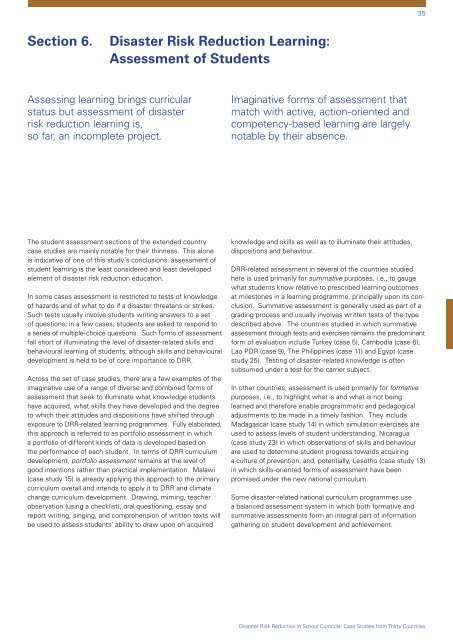Disaster Risk Reduction in School Curricula: Case Studies ... - Unicef
Disaster Risk Reduction in School Curricula: Case Studies ... - Unicef
Disaster Risk Reduction in School Curricula: Case Studies ... - Unicef
Create successful ePaper yourself
Turn your PDF publications into a flip-book with our unique Google optimized e-Paper software.
35<br />
Section 6.<br />
<strong>Disaster</strong> <strong>Risk</strong> <strong>Reduction</strong> Learn<strong>in</strong>g:<br />
Assessment of Students<br />
Assess<strong>in</strong>g learn<strong>in</strong>g br<strong>in</strong>gs curricular<br />
status but assessment of disaster<br />
risk reduction learn<strong>in</strong>g is,<br />
so far, an <strong>in</strong>complete project.<br />
Imag<strong>in</strong>ative forms of assessment that<br />
match with active, action-oriented and<br />
competency-based learn<strong>in</strong>g are largely<br />
notable by their absence.<br />
The student assessment sections of the extended country<br />
case studies are ma<strong>in</strong>ly notable for their th<strong>in</strong>ness. This alone<br />
is <strong>in</strong>dicative of one of this study’s conclusions: assessment of<br />
student learn<strong>in</strong>g is the least considered and least developed<br />
element of disaster risk reduction education.<br />
In some cases assessment is restricted to tests of knowledge<br />
of hazards and of what to do if a disaster threatens or strikes.<br />
Such tests usually <strong>in</strong>volve students writ<strong>in</strong>g answers to a set<br />
of questions; <strong>in</strong> a few cases, students are asked to respond to<br />
a series of multiple-choice questions. Such forms of assessment<br />
fall short of illum<strong>in</strong>at<strong>in</strong>g the level of disaster-related skills and<br />
behavioural learn<strong>in</strong>g of students, although skills and behavioural<br />
development is held to be of core importance to DRR.<br />
Across the set of case studies, there are a few examples of the<br />
imag<strong>in</strong>ative use of a range of diverse and comb<strong>in</strong>ed forms of<br />
assessment that seek to illum<strong>in</strong>ate what knowledge students<br />
have acquired, what skills they have developed and the degree<br />
to which their attitudes and dispositions have shifted through<br />
exposure to DRR-related learn<strong>in</strong>g programmes. Fully elaborated,<br />
this approach is referred to as portfolio assessment <strong>in</strong> which<br />
a portfolio of different k<strong>in</strong>ds of data is developed based on<br />
the performance of each student. In terms of DRR curriculum<br />
development, portfolio assessment rema<strong>in</strong>s at the level of<br />
good <strong>in</strong>tentions rather than practical implementation. Malawi<br />
(case study 15) is already apply<strong>in</strong>g this approach to the primary<br />
curriculum overall and <strong>in</strong>tends to apply it to DRR and climate<br />
change curriculum development. Draw<strong>in</strong>g, mim<strong>in</strong>g, teacher<br />
observation (us<strong>in</strong>g a checklist), oral question<strong>in</strong>g, essay and<br />
report writ<strong>in</strong>g, s<strong>in</strong>g<strong>in</strong>g, and comprehension of written texts will<br />
be used to assess students’ ability to draw upon on acquired<br />
knowledge and skills as well as to illum<strong>in</strong>ate their attitudes,<br />
dispositions and behaviour.<br />
DRR-related assessment <strong>in</strong> several of the countries studied<br />
here is used primarily for summative purposes, i.e., to gauge<br />
what students know relative to prescribed learn<strong>in</strong>g outcomes<br />
at milestones <strong>in</strong> a learn<strong>in</strong>g programme, pr<strong>in</strong>cipally upon its conclusion.<br />
Summative assessment is generally used as part of a<br />
grad<strong>in</strong>g process and usually <strong>in</strong>volves written tests of the type<br />
described above. The countries studied <strong>in</strong> which summative<br />
assessment through tests and exercises rema<strong>in</strong>s the predom<strong>in</strong>ant<br />
form of evaluation <strong>in</strong>clude Turkey (case 5), Cambodia (case 6),<br />
Lao PDR (case 9), The Philipp<strong>in</strong>es (case 11) and Egypt (case<br />
study 25). Test<strong>in</strong>g of disaster-related knowledge is often<br />
subsumed under a test for the carrier subject.<br />
In other countries, assessment is used primarily for formative<br />
purposes, i.e., to highlight what is and what is not be<strong>in</strong>g<br />
learned and therefore enable programmatic and pedagogical<br />
adjustments to be made <strong>in</strong> a timely fashion. They <strong>in</strong>clude<br />
Madagascar (case study 14) <strong>in</strong> which simulation exercises are<br />
used to assess levels of student understand<strong>in</strong>g, Nicaragua<br />
(case study 23) <strong>in</strong> which observations of skills and behaviour<br />
are used to determ<strong>in</strong>e student progress towards acquir<strong>in</strong>g<br />
a culture of prevention, and, potentially, Lesotho (case study 13)<br />
<strong>in</strong> which skills-oriented forms of assessment have been<br />
promised under the new national curriculum.<br />
Some disaster-related national curriculum programmes use<br />
a balanced assessment system <strong>in</strong> which both formative and<br />
summative assessments form an <strong>in</strong>tegral part of <strong>in</strong>formation<br />
gather<strong>in</strong>g on student development and achievement.<br />
<strong>Disaster</strong> <strong>Risk</strong> <strong>Reduction</strong> <strong>in</strong> <strong>School</strong> <strong>Curricula</strong>: <strong>Case</strong> <strong>Studies</strong> from Thirty Countries

















